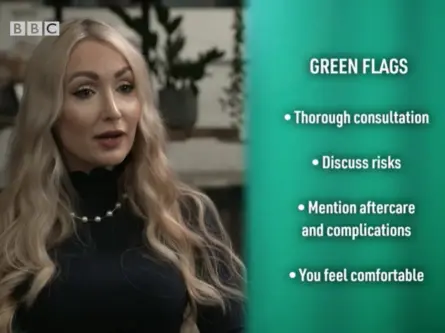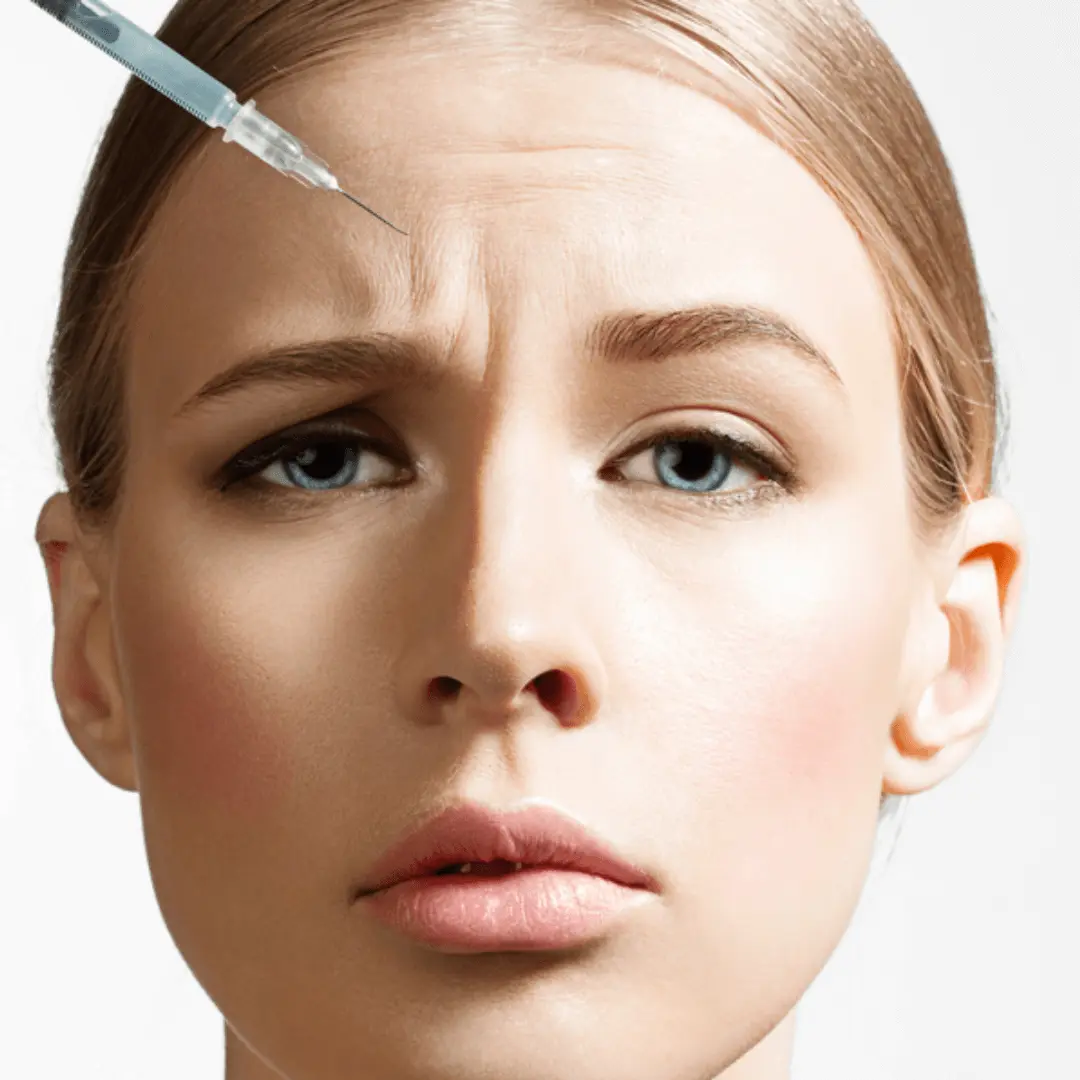When did we become so obsessed with chasing a certain look? From Instagram’s selfie culture to how young women really feel about ageing, in our series Changing Faces we'll take a frank and poignant look at the complex and often strained relationship many of us have with our appearance — and how this has been exacerbated by social media over the years.
Twenty-seven-year-old Shelley* is in £2,300 worth of credit card debt. She can only afford to pay off between £50 and £90 per month. How did she end up here?
"Getting Botox on my forehead costs me £400 every time but I can’t not have it," explains the PR account director from Buckinghamshire. "I get it done roughly every four months."
Botox (Botulinum toxin) injections relax the muscles in your face to smooth out lines and wrinkles. It is not permanent and usually lasts between three and four months.
In recent years Botox and fillers — also known as 'tweakments' — have become increasingly normalised and mainstream. The idea is that these anti-ageing and plumping, nonsurgical treatments can 'tweak' a person's appearance without being too invasive. They have given us celebrities who, miraculously, do not age — and, of course, super plump 'Love Island lips'.
The complexities of anti-ageing treatments are almost impossible to resolve. For years, women in particular have been sold creams and serums which profess to be elixirs of eternal youth and beauty. In many ways Botox is no different but there are very real concerns about the industry's lack of proper regulation.
As things stand, anyone can inject Botox. Yes, you read that correctly. However this could soon be about to change. At the end of last month the government announced an amendment to the Health and Care Bill which will give the health secretary powers to introduce a licence for nonsurgical cosmetic procedures such as Botox and fillers. This move follows on from the government’s decision to introduce a ban on Botox and lip fillers (when being done for cosmetic purposes) for under-18s in England.
Risks and regulatory intervention aside, Shelley loves Botox. "I know I’m only 27 but there’s no better feeling than my forehead not being able to move," she says. "I don’t look as youthful and my makeup doesn’t go on as well when it wears off.
These injectable treatments may not involve going under general anaesthetic but that doesn’t mean they come cheap. Botox and filler injections for cosmetic reasons are not available on the NHS and, generally speaking, the cost varies from around £100 to £350 per treatment, depending on the clinic and the area that is being treated.
Over 40% of the complaints we receive are from women aged between 25 and 35 who have taken to social media to find discounted treatments and have suffered complications and adverse reactions.
ASHTON COLLINS, SAVE FACE
Shelley explains that she started to get into debt to keep up with her treatments last summer. "I had lots of things to pay for," she says. "A new car because commuting had come back. I didn’t take out a credit card specifically for my Botox. I took it out for emergencies and to build my credit score."
However, for Shelley, keeping up with her Botox injections started to feel like a necessity. She began to use her credit card because she felt it was "an emergency" when her "forehead was starting to get movement back" and she had other expenses to account for.
Shelley has Botox every four or five months. She has recently moved to a cheaper clinic (a woman who does it from a room on the side of her house) but nonetheless it costs her over £1,000 a year.
Shelley is not the only young woman spending huge amounts of money on her beauty regime. New analysis from Pamperbook (a booking app for hair and beauty treatments) reveals the true cost of pursuing youth and beauty. Pamperbook surveyed 900 hair and beauty salons and found that, on average, women are spending a combined cost of over £1,000 each month on nails, hair and aesthetics such as facials and injectables.
According to Pamperbook, by far the biggest proportion of beauty spending each month is on injectables and laser facials which, on average, cost customers somewhere between £400 and £500.
Like Shelley, Michelle* loves Botox. She started to get it when she was 30 years old because she was afraid that she would start to show signs of ageing.
"For years I lived in my overdraft and I still got my Botox," she explains.
Michelle, a copywriter who is also from Buckinghamshire, has Botox every four months or so at around £180 a time. She estimates that she has spent over £2,000 on it in recent years.
"I would buy cheap clothes, I would get my friends to cut my hair, I would dye my hair at home… Everything else would be cheap as hell but I had to prioritise Botox above all else," she says. Why? The answer is simple. "I really, really don’t want to look old," Michelle continues. "I would never lie about having it, I find the secrecy rather anti-feminist to be honest."
Pressures of social media filters and influencers are a huge catalyst for the huge uptake among young women.
ASHTON COLLINS, SAVE FACE
When considering the motivation to drop these sums of money, particularly against the backdrop of rising housing costs, energy bills, childcare costs and expensive supermarket shops, it’s impossible to ignore the pressures that young women face when it comes to their appearance. It’s also impossible to overlook the fact that Botox and fillers are even available today on a buy now, pay later basis at some clinics, as Refinery29 has previously reported. This, surely, encourages the normalisation of spending money you don't have on something you can't actually afford.
Ashton Collins is the director of Save Face, a national register of accredited practitioners who provide nonsurgical cosmetic treatments such as anti-wrinkle injections and dermal fillers.
"There has been an explosive rise in the number of young women seeking nonsurgical cosmetic interventions in the past five years," Collins explains. "Last year, over 70% of people who used our website to research treatments and find practitioners were women aged between 25 and 35."
As Collins sees it, there is a clear reason for the demand for Botox and dermal fillers among younger women. "Pressures of social media filters and influencers are a huge catalyst for the huge uptake among this age group but there is a downside," she reflects. "These sorts of treatments are not cheap and because they are temporary they need to be topped up every few months, which can put a financial strain on younger people with less disposable income. Once you have become accustomed to the way you look after having a cosmetic treatment, it can make you reluctant to give that up, even if you can’t really afford it."
The consequences can be serious. Collins says that she, too, has heard of people turning to credit cards and loans to fund their treatments. More than that, she adds: "The financial pressure can often lead them to fall into unsafe hands by looking for cut-price alternatives. Over 40% of the complaints we receive are from women aged between 25 and 35 who have taken to social media to find discounted treatments and have suffered complications and adverse reactions."
In Oscar Wilde’s novel The Picture of Dorian Gray, the character of Dorian Gray does a deal with the devil in an attempt to preserve his youth. He trades his soul. When administered safely, Botox can be highly effective if you want to erase the signs of ageing — the marks left by every smile, laugh and frown of a life well-lived. But it comes at a cost. At best, that cost is financial. At worst, it can cause irreversible damage to your appearance and health. As Refinery29 has previously reported, in the hands of a novice, badly administered filler can lead to blocked blood vessels, which is a catastrophic emergency as it can result in necrosis (death of skin tissue).
An expensive anti-ageing skin cream might leave you in debt but it won’t cause this sort of damage. Ultimately, Collins says that Botox and fillers are costly for a reason. "These treatments are medical interventions that can cause permanent damage if they are injected incorrectly," she says. "Don’t cut corners, find a reputable and trustworthy practitioner who has the expertise to help you get the most effective treatments to suit your budget."
Michelle is now out of her overdraft but has no plans to stop getting Botox. "I got it because I didn’t want to be wrinkly but now I think it is the one thing I can’t live without." Shelley is still in credit card debt but equally has no plans to forgo Botox. "I just hate my face when it wears off," she says.
You can use Save Face’s government-approved register www.saveface.co.uk to find your nearest accredited practitioner.













